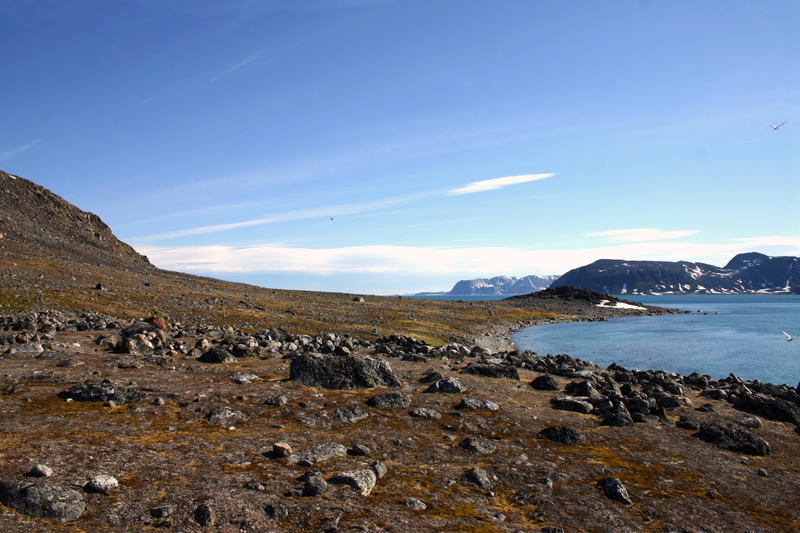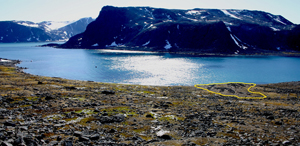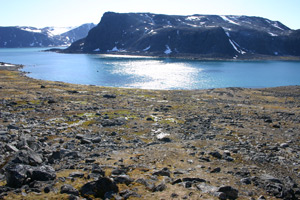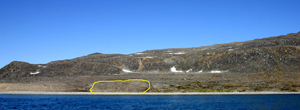|
|
Ytre Norskøya
[79° 50' N 11° 30' E]
By Øystein Overrein (ed.), Jørn Henriksen, Bjørn Fossli Johansen, Kristin Prestvold
Ytre Norskøya is situated in the middle of what used to be the Dutch whaling area in the early 1600s, when it all revolved around land-based stations for boiling the whale blubber. The station is situated by the sound Norskøysundet, between the islands of Ytre Norskøya and Indre Norskøya. A sheltered bay offers protection against the weather and a broad beach facilitates landings. Today, the remains of nine blubber ovens lie in a line along the beach in the bay. The area with 165 graves on the island is one of the largest burial grounds in Svalbard.
 View from Ytre Norskøya eastwards toward the graves, the bay and Biscayarhuken in the background. (Image: Bjørn Fossli Johansen / The Norwegian Polar Institute) Take care:
- Go ashore to the west of the graves, and continue, if you wish, up to Utkiken.
- Do not walk inside the area of the graves. It is easy to spot from the heap of gravel on the west.
- It is not allowed to remove, harm or damage the cultural treasures.
- Do not go ashore inside the bay. There are blubber ovens on the beach here, and they cannot withstand traffic.
- Do not tread on the flat area to the east of where you go ashore. The blubber ovens can be observed just as well from the sea.
- Bear in mind that the Ministry of the Environment is considering regulating traffic on Ytre Norskøya.
 View from Ytre Norskøya towards Norskøysundet and Indre Norskøya. The area with the graves has been marked in yellow. The area to the east of it (to the left in the picture) is moist ground, and there are moss tundra and blubber ovens along the beach. These are vulnerable and should not be walked on. Go ashore to the west of the graves (to the right in the picture). It is a nice walk along the gravelled hill here, which does not harm vegetation or cultural treasures. (Image: Bjørn Fossli Johansen / The Norwegian Polar Institute) View from Ytre Norskøya towards Norskøysundet and Indre Norskøya. The area with the graves has been marked in yellow. The area to the east of it (to the left in the picture) is moist ground, and there are moss tundra and blubber ovens along the beach. These are vulnerable and should not be walked on. Go ashore to the west of the graves (to the right in the picture). It is a nice walk along the gravelled hill here, which does not harm vegetation or cultural treasures. (Image: Bjørn Fossli Johansen / The Norwegian Polar Institute)
 View from Ytre Norskøya towards Norskøysundet and Indre Norskøya. (Image: Bjørn Fossli Johansen / The Norwegian Polar Institute) View from Ytre Norskøya towards Norskøysundet and Indre Norskøya. (Image: Bjørn Fossli Johansen / The Norwegian Polar Institute)
 Overview from the sea. The area of the graves has been marked in yellow. The recommended place to go ashore lies to the west of it (to the left in the photo). (Image: Bjørn Fossli Johansen / The Norwegian Polar Institute) Overview from the sea. The area of the graves has been marked in yellow. The recommended place to go ashore lies to the west of it (to the left in the photo). (Image: Bjørn Fossli Johansen / The Norwegian Polar Institute)
Ytre Norskøya – remains of the old whaling period
Ytre Norskøya was deemed a good place to be by the British in the early 1600s – years before the whaling station was built. The island is a part of the Nordvestøyane island group. The area consists of islands and sounds and is therefore ideal to anchor in, and it also offers shelter from the weather. The open sea is close by. The area was named Fair Haven.
The whaling station on Ytre Norskøya was one of the really large land-based ones in Svalbard. Its size can be compared to Smeerenburg, further south. In terms of fame, however, it cannot be compared to the legendary Smeerenburg. However, the station must have been very important at one point. As many as nine ovens are lined up along the beach in the bay to the north of Norskøysundet. Some are single ovens, others are double. Several sites above and to the west of the ovens are thought to be remains of the provisional structures which were used to shelter, storage spaces and workshops in the early period. It is also possible to find the remains of working platforms for carving whale blubber, platforms for cooling vessels and other constructions necessary for rendering whale oil.
No archaeological digs have been carried out at the whaling stations on Ytre Norskøya. However, archaeological work has been carried out at the graves, situated on the gravel hill just above the station. With 165 graves, it is one of the largest grave sites in Svalbard. At the time when Smeerenburg was excavated, so were 50 of these graves. They were examined by Dutch archaeologists in 1980. Any preserved whaler’s outfits and other textiles from the graves were taken to the Netherlands and are today a part of the Smeerenburg Collection, large parts of which were returned to Svalbard in 2005. Today parts of the collection are on display at the Svalbard Museum.
Vulnerable elementsMany traces of the old whalers remain on Ytre Norskøya. They are robust and still clear, even though nature has worn down the remains over the course of the years.
The remains of the whaling station can be found down by the shore. Almost all the ovens have slipped towards the beach, and are threatened by erosion. The ovens are vulnerable and cannot withstand being stepped on.
The area of the graves has had a lot of visitors, and it shows. The graves are on a gravelled hill covered with a thin layer of vegetation, most of which has been worn away by traffic.
The island and its surrounding area are highly valued as a historical site. It is well worth a visit on account of the large number of ovens and constructions from the whaling station, and the cemetery close by. Make sure that what is left from the old whaling days remains a source of interest in the future! Landing sitesGo ashore to the west of the graves to avoid harmful erosion on the part that lies closest to the sea and to the blubber ovens which are scattered in the east along the whole of the beach. Recommended trailsThere is a good place to take photographs on the hill to the west of the graves. It is also common to walk up the mountain Utkiken, at the the top of the island.
|
The Cruise Handbook is also available in book form
Order now
Hard cover with numerous pictures - 249 pages - NOK 249.00
Norwegian Polar Institute
Fram Centre
NO-9296 Tromsø
NORWAY
|